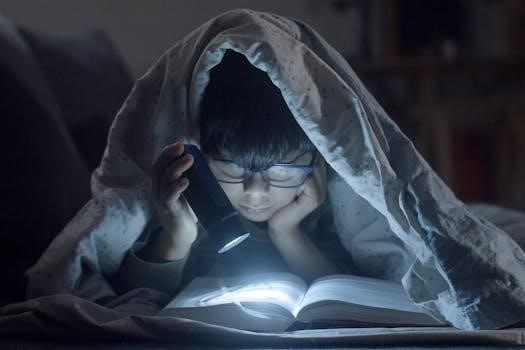Overview of “The Bloody Chamber and Other Stories”
Angela Carter’s “The Bloody Chamber and Other Stories” is a collection that reimagines classic fairy tales with a gothic twist. These stories explore themes of female empowerment, sexuality, and transformation, often challenging traditional narratives and societal expectations. The collection offers a dark, sensual, and thought-provoking experience.
Themes in Angela Carter’s Work
Carter’s work delves into various themes, most notably female empowerment, challenging traditional gender roles through her characters. Sexuality and transformation are also prominent, often intertwined with gothic elements of darkness and the uncanny. Her stories are very thought provoking.
Female Empowerment
Female empowerment is a central theme in Angela Carter’s works, particularly in “The Bloody Chamber and Other Stories.” She actively challenges traditional fairy tale portrayals of women as passive victims or damsels in distress. Carter’s heroines often seize agency, defying societal expectations and patriarchal structures. They actively make choices that determine their fate and challenge the constraints placed upon them.
By reimagining these narratives, Carter offers a feminist revision of classic tales, presenting women who are capable of resilience, resistance, and self-discovery. Her characters navigate perilous situations, confronting their fears and ultimately finding strength within themselves. This theme resonates throughout the collection, contributing to its enduring appeal and critical acclaim; The stories serve as a way to inspire woman.
Sexuality and Transformation
“The Bloody Chamber and Other Stories” delves into the complex interplay of sexuality and transformation. Carter explores how characters’ understanding and experience of their sexuality can be a catalyst for profound personal change. The stories often depict a journey of self-discovery, where characters grapple with societal expectations, desire, and the boundaries of their own bodies.
Sexuality is not presented as purely romantic or idealized; instead, it’s often intertwined with power dynamics, danger, and the potential for both liberation and exploitation. Through encounters with the erotic and the grotesque, characters undergo metamorphosis, shedding old identities and embracing new, often unconventional, versions of themselves. This exploration of sexuality as a transformative force is a hallmark of Carter’s unique and provocative style, challenging conventional notions of femininity and desire. The stories promote sexual exploration.
Gothic Elements
Angela Carter’s “The Bloody Chamber and Other Stories” is steeped in the rich tradition of Gothic literature. The collection employs classic Gothic tropes such as dark, imposing settings, an atmosphere of suspense and dread, and the exploration of the macabre and the supernatural. Characters often find themselves isolated within crumbling castles or remote estates, cut off from the outside world and vulnerable to the forces of darkness.
These settings become symbolic landscapes, reflecting the internal turmoil and psychological struggles of the protagonists. Carter utilizes elements of horror, mystery, and the grotesque to create a sense of unease and foreboding. The presence of ancestral curses, hidden secrets, and forbidden chambers further contributes to the Gothic atmosphere. By drawing upon these conventions, Carter crafts a world where the boundaries between reality and nightmare blur, and where the past continues to haunt the present. The gothic elements reveal a sinister atmosphere.
“The Bloody Chamber”⁚ A Tale of Peril and Liberation
The titular story, “The Bloody Chamber,” is a potent reimagining of the Bluebeard fairy tale, serving as a cornerstone of Angela Carter’s collection. It delves into the themes of female vulnerability and eventual empowerment within a chillingly opulent setting. The young, unnamed protagonist finds herself married to a wealthy and enigmatic Marquis, whose dark secrets slowly unravel as she explores his ancestral home.
The story masterfully builds suspense, drawing the reader into a world of lavish excess and impending doom. As the bride uncovers the Marquis’s history of violence and the gruesome fate of his previous wives, she confronts the peril that surrounds her. However, “The Bloody Chamber” is not simply a tale of victimization. Through her ordeal, the protagonist undergoes a transformative journey, ultimately seizing agency and escaping the clutches of her oppressor. It explores the themes of sexuality and transformation in the face of danger.

Reimagining Fairy Tales
Carter masterfully reimagines classic fairy tales, extracting latent content to create divergent pieces. She uses familiar narratives as frameworks to explore darker, more complex themes, often subverting traditional morals and expectations.
Bluebeard
In “The Bloody Chamber,” Carter retells the Bluebeard tale with a distinct feminist lens. The story follows a young bride who marries a wealthy, older Marquis. Her initial excitement turns to dread as she uncovers the dark secrets hidden within his opulent castle. The titular bloody chamber itself symbolizes the Marquis’ sinister past and the violence he has inflicted upon previous wives.
The heroine’s journey is one of peril, as she confronts the reality of her husband’s monstrous nature. However, unlike traditional versions of the tale, Carter empowers the protagonist. She actively investigates the forbidden chamber, seeking knowledge and ultimately finding liberation from her oppressor. The story explores themes of female curiosity, the dangers of patriarchal power, and the potential for female agency in the face of horror. The mother saves her daughter, which shows that women are their own saviors.
Red Riding Hood
Carter’s reimagining of Red Riding Hood appears in several stories within “The Bloody Chamber,” most notably in “The Werewolf” and “The Company of Wolves.” These tales subvert the traditional narrative of a vulnerable girl threatened by a predatory wolf. Instead, Carter presents a Red Riding Hood figure who is resourceful, resilient, and capable of confronting danger on her own terms.
In “The Company of Wolves,” the young woman actively seeks out the wolf, displaying a fearless curiosity that challenges the conventional image of female passivity. The story explores the blurred lines between humans and animals, desire and danger, and innocence and experience. Carter uses the Red Riding Hood motif to examine female sexuality and agency, suggesting that women can navigate the perils of the world with intelligence and self-assurance. The traditional fear of the wolf is transformed into a celebration of female strength and independence. The grandmother is not killed and eaten.

Gothic Tradition in “The Bloody Chamber”
Carter’s collection is steeped in gothic elements. She uses darkness, suspense, and the macabre to explore hidden desires and societal anxieties. “The Bloody Chamber” draws on classic gothic tropes, like the isolated setting and the threat of violence.
Darkness as a Motif
Darkness pervades “The Bloody Chamber” acting as a multi-layered motif. It represents not only the literal absence of light, creating an atmosphere of suspense and foreboding, but also the hidden aspects of the characters’ psyches and the concealed sins within the stories’ settings. The titular chamber itself embodies this, a place of secrets and horrors veiled in darkness.
This darkness mirrors the unknown, the repressed desires, and the potential for both danger and liberation. It obscures the truth, forcing characters (and readers) to confront the unsettling aspects of human nature. The darkness serves as a constant reminder of the fragility of innocence and the ever-present potential for corruption and violence, highlighting the gothic elements and the characters’ internal struggles.
Instruments of Mutilation
The presence of instruments of mutilation is a disturbing and potent element in “The Bloody Chamber.” These objects, often explicitly described, serve as physical manifestations of the violence and power dynamics inherent in the stories. They represent the threat of physical harm, but also symbolize the potential for psychological and emotional violation. The instruments are not simply tools of destruction; they are imbued with a symbolic weight that speaks to the deeper themes of control, dominance, and the violation of the female body;
These instruments highlight the vulnerability of the heroines. The threat they represent underscores the precarious position of women within the patriarchal structures depicted in the collection. Furthermore, their presence forces a confrontation with the brutal realities that lie beneath the surface of the seemingly beautiful and romantic worlds Carter creates. They are visceral reminders of the potential for pain and the ever-present threat of male aggression.

Feminist Revisionism
“The Bloody Chamber and Other Stories” is widely recognized for its feminist revisionism, a critical re-examination and rewriting of traditional narratives from a feminist perspective. Angela Carter takes familiar fairy tales and folk stories, dismantling their patriarchal underpinnings and reimagining them to empower female characters. She challenges the passive roles often assigned to women in these tales, giving her heroines agency and a voice. The stories actively subvert conventional expectations of female behavior and destiny.
Carter’s feminist approach involves exploring female sexuality, challenging notions of purity and victimhood, and celebrating female strength and resilience. The collection reinterprets classic tropes, giving women the power to escape their predetermined roles and actively shape their own narratives. By exposing the latent content within these stories, Carter offers a commentary on the social and cultural forces that have historically oppressed women, while also providing alternative models of female identity and liberation. The female characters are not simply victims, but active participants in their own destinies.

Availability of “The Bloody Chamber and Other Stories” in PDF Format
“The Bloody Chamber and Other Stories” is widely available in PDF format across various online platforms. Several websites offer free downloads of the book, making it accessible to a broad audience. These digital versions allow readers to enjoy Angela Carter’s collection on their preferred devices, such as computers, tablets, and e-readers, enhancing convenience and portability. Online archives and digital libraries often host PDF copies of the book, ensuring its preservation and accessibility for future generations.
However, it is crucial to ensure that the downloaded PDF is from a reputable source to avoid copyright infringement and potential malware. Many educational institutions and literary websites provide legitimate PDF versions for academic or personal use. The availability of “The Bloody Chamber and Other Stories” in PDF format facilitates its study and appreciation by students, scholars, and general readers interested in feminist literature, gothic fiction, and the reimagining of fairy tales. It also enables easy sharing and discussion of the work within online literary communities.
Critical Reception and Analysis
“The Bloody Chamber and Other Stories” has garnered significant critical attention since its publication, establishing Angela Carter as a pivotal figure in contemporary literature. Critics often praise Carter’s innovative approach to fairy tales, recognizing her ability to subvert traditional narratives and explore complex themes of gender, sexuality, and power. The collection is frequently analyzed through a feminist lens, with scholars examining Carter’s deconstruction of patriarchal structures and her creation of empowered female characters.
Reviewers have also highlighted the gothic elements present in the stories, noting Carter’s skillful use of atmosphere, symbolism, and macabre imagery. The collection’s exploration of desire, violence, and transformation has sparked considerable debate and interpretation among literary critics. Many academic essays and books delve into the intricate layers of meaning within Carter’s work, analyzing her literary techniques and the socio-cultural contexts that inform her writing. “The Bloody Chamber” continues to be a subject of scholarly inquiry, solidifying its place as a significant and enduring contribution to modern literature.

No Responses